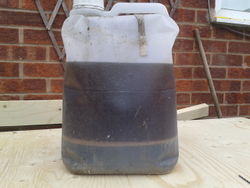Difference between revisions of "Waste vegetable oil"
| (10 intermediate revisions by 4 users not shown) | |||
| Line 1: | Line 1: | ||
| + | <metadesc>All about Waste Vegetable Oil for making Biodiesel</metadesc> | ||
{{Stub}} | {{Stub}} | ||
| + | Waste Vegetable Oil (aka Used Cooking Oil) is acidic oil from cooking. The acidity is in the form of [[free fatty acid]], which is created by the water content of food being fried, and the high temperature of the oil. The more used the oil, the higher the free fatty acid content. | ||
| − | + | [[File:Wvo.jpg|250px|thumb|right|A typical "cubie" of WVO showing separate layers of oil, fats and water]] | |
| − | + | [[Titration]] can determine level of free fatty acid, if the oil is to be used to make [[biodiesel]]. | |
| − | [[Category: | + | Oil that is exposed to oxygen for an extended time polymerises into a sticky, hard to remove goo. This can be removed from the surface of containers with petrol or [[isopropyl alcohol]]. |
| + | |||
| + | Waste oil needs to be stored and handled carefully as it can attract vermin such as rats, which can carry [http://en.wikipedia.org/wiki/Category:Rodent-carried_diseases life threatening diseases]. | ||
| + | |||
| + | Please see the [[Environment Agency and waste transfer notes]] page for advice on the proper collection, storage and documentation of waste oils. | ||
| + | |||
| + | Generally, waste vegetable oil can be stored for a year or more if kept in sealed containers free from water content. | ||
| + | |||
| + | [[Category:Biodiesel]] | ||
| + | [[Category:Ingredients and preparation]] | ||
| + | [[Category:Vegetable oil]] | ||
| + | [[Category:Introduction to veg oil use]] | ||
Latest revision as of 14:56, 19 April 2013
Waste Vegetable Oil (aka Used Cooking Oil) is acidic oil from cooking. The acidity is in the form of free fatty acid, which is created by the water content of food being fried, and the high temperature of the oil. The more used the oil, the higher the free fatty acid content.
Titration can determine level of free fatty acid, if the oil is to be used to make biodiesel.
Oil that is exposed to oxygen for an extended time polymerises into a sticky, hard to remove goo. This can be removed from the surface of containers with petrol or isopropyl alcohol.
Waste oil needs to be stored and handled carefully as it can attract vermin such as rats, which can carry life threatening diseases.
Please see the Environment Agency and waste transfer notes page for advice on the proper collection, storage and documentation of waste oils.
Generally, waste vegetable oil can be stored for a year or more if kept in sealed containers free from water content.
